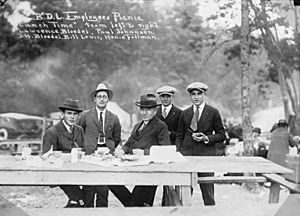Julius Bloedel facts for kids
Quick facts for kids
Julius Bloedel
|
|
|---|---|

Bloedel-Donovan Lumber Employees Picnic, 'Lunch Time' from left to right Lawrence Bloedel, Paul Johansen, J.H. Bloedel. Bill Lewis, Henie Follman, July 22, 1922
|
|
| Born |
Julius Harold Bloedel
March 4, 1864 |
| Died | September 21, 1957 (aged 93) |
| Nationality | American |
| Occupation | Timber merchant |
| Known for | Co-founding Bloedel, Stewart and Welch |
| Relatives | Virginia Wright (granddaughter) |
Julius Harold Bloedel (born March 4, 1864 – died September 21, 1957) was an American businessman. He was an entrepreneur who worked mostly in the Pacific Northwest of the United States and Canada.
Contents
Early Life and Business Beginnings
Julius Bloedel was born in Fond du Lac, Wisconsin. In 1890, he moved to Fairhaven, Washington. This town later became part of Bellingham. There, he became the president of Fairhaven National Bank.
Bloedel started several businesses in this new frontier area. These included the Samish Lake Lumber and Mill Company and the Blue Canyon Coal Mines. He also worked closely with other early settlers of Bellingham. Even though some of these businesses didn't last, Bloedel was good with money. His skills helped him survive tough economic times.
Founding a Lumber Company
In August 1898, Bloedel started the Whatcom Logging Company. He partnered with other businessmen, John Joseph Donovan and Peter Larson. This company later became known as the Bloedel-Donovan Lumber Mills. Today, there is a park in Bellingham named Bloedel Donovan Park. It is located where Bloedel's first lumber mill once stood. He gave this land to the city as a park in 1946.
Expanding into Canada
Julius Bloedel wanted to make his lumber business even bigger. He used his existing company in Bellingham as a way to get money. With this, he started buying land in Canada. In 1911, he found two new partners, John Stewart and Patrick Welch. They came to Canada and bought large areas of forests on British Columbia's Vancouver Island.
Their new company was called Bloedel, Stewart and Welch. This Canadian business soon became much larger than Bloedel's earlier projects. Their logging camp at Franklin River became one of the biggest logging operations in the world. In the 1930s, this camp was the first in Canada to use a steel spar and a chainsaw for logging. Patrick Welch and John Stewart also worked on building the Pacific Great Eastern Railway. They did this with another partner as Foley, Welch & Stewart.
Later Life and Legacy
In the fall of 1911, the same year he started his Canadian logging business, Julius Bloedel moved to Seattle. He lived there with his wife, Mina Louise Prentice. They had three children: Prentice, Lawrence, and Charlotte. Julius Bloedel passed away in Seattle in 1957.
Company Growth and Mergers
In the 1950s, Julius Bloedel's son, Prentice, took over the company. Under his leadership, the company joined with the HR MacMillan Company. They formed one of the largest forest products companies in the world. This new company was called MacMillan Bloedel Limited, often known as "Mac-Blo." Later, in 1999, another company called Weyerhaeuser took over MacMillan Bloedel.
Places Named After the Family
Several places are named after Julius Bloedel and his family:
- Bloedel Hall at the University of Washington in Seattle is named for Julius Bloedel.
- The Bloedel Conservatory in Queen Elizabeth Park in Vancouver is named for his son Prentice Bloedel. Prentice donated almost $1.4 million for its construction in 1967.
- The Bloedel Reserve on Bainbridge Island, Washington, was created by Prentice Bloedel and his wife, Virginia.
Family's Contributions to Arts
Julius Bloedel's son, Lawrence Bloedel, was a librarian at Williams College. When he died, his collection of 300 artworks was given to the Whitney Museum of American Art and the Williams College Museum of Art. After Lawrence's death, his wife, Eleanore Bloedel, gave Field Farm in Williamstown, Massachusetts to The Trustees of Reservations. Julius Bloedel's granddaughter, Virginia Wright, married businessman Bagley Wright. She was a well-known art collector and helped many art organizations in the Pacific Northwest.

